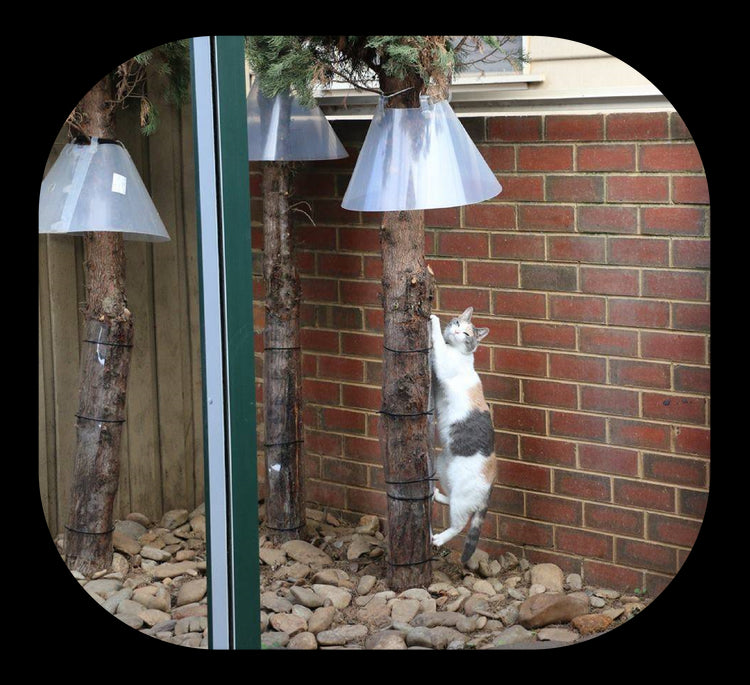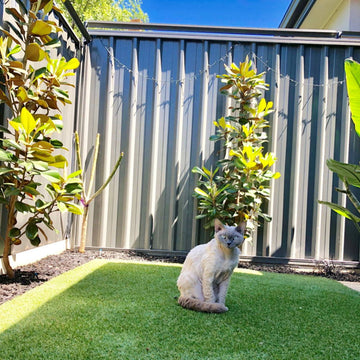Winter-Proof Tree Guards: Best Systems for Cold Climates

Protecting trees in cold climates is important for their health and survival. Trees face many challenges during winter, including extreme temperatures, moisture loss, and damage from ice, snow, and animals. Without proper protection, trees can suffer lasting harm that may lead to stunted growth, diseases, or death.
Key Takeaways:
- Winter protection is crucial for tree health and survival in cold climates
- Trees face multiple threats including temperature extremes, moisture loss, and physical damage
- Proper tree guards can mitigate winter risks and promote long-term tree health
- The Oscillot Cat Tree Guard offers dual protection against winter threats and cat climbing
- Effective tree protection systems should be durable, flexible, and allow for proper ventilation
Winter protection for trees isn't just about looks; it's about ensuring the long-term health of your landscape. Trees face many threats during cold months, including temperature extremes, moisture loss, and damage from ice, snow, and animals. Without proper protection, trees can suffer lasting harm, leading to stunted growth or even death. The impact of winter damage can extend far beyond the cold season, affecting the tree's ability to thrive in spring and summer. Proper winter protection is an investment in the future beauty and health of your outdoor space.
In cold climates, trees are especially vulnerable. The harsh conditions can cause bark splitting, branch breakage, and root damage. Changing temperatures can lead to frost cracks and sunscald, particularly in young or thin-barked trees. These issues not only affect how the tree looks but can also let pests and diseases in, putting the tree's overall health at risk. Additionally, the stress of winter can weaken trees, making them more susceptible to problems in the following growing season. Protecting trees during winter is crucial for maintaining a healthy, vibrant landscape year-round.
Our Cat Tree Guard system is designed to tackle these challenges, offering a tough solution for protecting your trees throughout the winter months and beyond. Let's explore how our clever product can play a key role in your winter tree care plan. The Oscillot Cat Tree Guard not only addresses the specific issue of cat climbing but also provides an additional layer of protection against various winter threats, making it a versatile addition to your tree care strategy.
Understanding Winter Threats to Trees
To effectively protect trees during winter, it's important to know the specific threats they face. Cold climates bring many challenges that can seriously impact tree health and longevity. Understanding these threats allows for more targeted and effective protection strategies, ensuring that trees not only survive the winter but emerge strong and healthy in spring.
Temperature Fluctuations
One of the biggest threats to trees in winter is rapid and extreme temperature changes. These fluctuations can cause several problems:
- Frost Cracks: Sudden drops in temperature can make the outer layer of the tree shrink faster than the inner wood, causing long splits in the trunk. These cracks can extend deep into the tree, providing entry points for pests and diseases.
- Root Damage: When soil repeatedly freezes and thaws, it can push shallow roots out of the ground, exposing them to cold air and potentially killing them. This process, known as frost heaving, can severely impact a tree's ability to absorb water and nutrients.
- Bud Death: Unusually warm periods followed by sharp cold snaps can kill flower and leaf buds, affecting the tree's growth and bloom in spring. This can be particularly devastating for fruit trees, potentially impacting crop yields.
- Cambium Layer Damage: Extreme cold can damage the cambium layer, the living tissue just beneath the bark responsible for the tree's growth. This can lead to sections of bark dying and falling off, a condition known as bark necrosis.
Sun Damage and Sunscald
While it might seem odd, sun exposure can be particularly damaging to trees in winter:
- Sunscald: On sunny winter days, the sun can warm up the south and southwest sides of tree trunks. When temperatures drop at night, this bark cools quickly, potentially killing the active tissue underneath. This can lead to bark cracking, peeling, or discolouration, and can make trees more susceptible to insect infestation and disease.
- Desiccation: Winter sun and wind can make evergreens lose water through their needles faster than they can replace it from frozen soil, leading to brown, dry needles. This is particularly common in newly planted or exposed evergreens and can result in needle loss or even branch death.
- Photooxidative Damage: Bright winter sunlight combined with cold temperatures can damage chlorophyll in evergreen needles, leading to discolouration and reduced photosynthetic capacity.
Wind and Ice Damage
Winter storms can cause a lot of harm to trees:
- Branch Breakage: Heavy snow and ice buildup can cause branches to break under the weight. This is particularly problematic for trees with weak branch unions or those that haven't been properly pruned.
- Wind Damage: Strong winter winds can make trees sway too much, potentially uprooting them or causing structural damage. Trees with shallow root systems or those in saturated soil are particularly vulnerable.
- Salt Spray: In areas where roads are salted, wind can carry salt spray onto nearby trees, causing dehydration and damage to buds and branches. Salt can also accumulate in the soil, affecting root health and nutrient uptake.
- Ice Glazing: A coating of ice can encase small twigs and branches, making them brittle and more susceptible to breakage. In severe cases, entire trees can collapse under the weight of ice.
Animal Damage (Including Cats)
Wildlife and pets can also pose threats to trees in winter:
- Bark Stripping: Animals like deer and rabbits may strip bark from trees when other food is scarce. This can girdle the tree, interrupting the flow of nutrients and potentially leading to death.
- Gnawing: Rodents often chew on tree bark and roots, which can girdle the tree and lead to its death. This is especially common when snow cover allows rodents to access higher parts of the trunk.
- Cat Climbing: While not typically thought of as winter damage, cats climbing trees can stress the bark and branches year-round, which is worse during winter when trees are more vulnerable. Cats can dislodge protective bark, creating entry points for pests and diseases.
- Bird Damage: Large bird populations can sometimes cause damage to buds and young shoots, particularly in fruit trees.
Our Cat Tree Guard is specifically designed to address this last point, protecting trees from the extra stress of cat climbing, which can be particularly damaging when trees are already battling harsh winter conditions. By preventing cats from accessing the tree, it helps maintain the integrity of the bark and reduces overall stress on the tree during its most vulnerable period.
Key Features of Effective Winter Tree Guards
When choosing a winter tree guard, it's important to pick a system that addresses the many challenges trees face in cold climates. Effective tree guards should have several key features to ensure the best protection. These features work together to create a comprehensive defense against winter threats while allowing for healthy tree growth and development.
Durability in Harsh Conditions
The main job of a winter tree guard is to stand up to the harsh elements of cold climates. Key aspects of durability include:
- Frost Resistance: The material should not crack or become brittle in freezing temperatures. This ensures the guard remains effective throughout the winter, even during extreme cold snaps.
- UV Stability: Guards must resist breaking down from sunlight exposure, even during winter months. This is particularly important for guards that remain in place year-round.
- Moisture Resistance: The guard should not absorb water or encourage fungal growth. This prevents the guard from becoming a source of moisture-related problems for the tree.
- Wind Resistance: It must stay in place during strong winter winds. This is crucial for maintaining consistent protection and preventing damage from the guard itself.
- Impact Resistance: The guard should withstand potential impacts from falling branches, ice, or snow without cracking or breaking.
Our Oscillot Cat Tree Guard is made with these factors in mind, using high-quality materials that stay strong through extreme weather conditions. The durable construction ensures long-lasting protection against both winter elements and cat climbing.
Proper Ventilation
While protection is crucial, trees still need to breathe. Effective tree guards should:
- Allow Air Circulation: This prevents moisture buildup that can lead to fungal growth or bark rot. Good air flow helps maintain a healthy microclimate around the tree trunk.
- Regulate Temperature: Proper ventilation helps reduce extreme temperature changes between the tree and its surroundings. This is particularly important in preventing sunscald on sunny winter days.
- Facilitate Transpiration: Trees continue to release water vapor even in winter, and guards should not stop this natural process. Proper transpiration is essential for maintaining the tree's water balance and overall health.
- Prevent Condensation: Guards should be designed to minimise condensation buildup, which can lead to ice formation and potential bark damage.
- Allow for Photosynthesis: For evergreen trees, guards should not completely block light, allowing for continued (albeit reduced) photosynthesis during winter months.
Flexibility for Tree Growth
Trees are living, growing organisms, and their protection should allow for this growth:
- Expandable Design: Guards should allow for trunk expansion without squeezing the tree. This is crucial for preventing girdling and ensuring healthy growth.
- Adjustable Components: The ability to adjust or add sections as the tree grows ensures long-term usefulness. This adaptability makes the guard a more cost-effective solution over time.
- Non-Restrictive Structure: The guard should not stop the natural movement of branches or trunk. This flexibility is important for the tree's overall structural development and health.
- Easy Removal and Reapplication: As trees grow, it should be simple to remove and reapply the guard to accommodate changes in trunk size or shape.
- Compatibility with Various Tree Sizes: An ideal guard system should be versatile enough to protect trees at different stages of growth, from saplings to mature specimens.
The Oscillot Cat Tree Guard system is designed with flexibility in mind, allowing for easy adjustments as your tree grows and changes over time. This adaptability ensures that the guard remains effective throughout the tree's life stages.
Easy Installation and Removal
Practicality is key when it comes to tree guards. They should be:
- Simple to Install: Guards that can be set up without special tools or expertise are ideal. This makes them accessible for homeowners and landscapers alike.
- Quick to Remove: Seasonal guards should be easy to take down when not needed. This allows for flexibility in tree care practices throughout the year.
- Reusable: High-quality guards should be durable enough for multiple seasons of use. This makes them a more sustainable and cost-effective choice in the long run.
- Low Maintenance: Once installed, guards should need minimal upkeep. This ensures consistent protection without requiring frequent attention.
- Non-Damaging: The installation and removal process should not cause any harm to the tree's bark or structure.
- Adaptable to Different Tree Types: The guard should be versatile enough to work with various tree species and shapes.
Our Cat Tree Guard shows these features, offering a user-friendly solution that can be easily installed, adjusted, and removed as needed. Its design prioritises both effectiveness and convenience, making it an excellent choice for both professional arborists and home gardeners.
Oscillot Cat Tree Guard: A Versatile Solution
At Oscillot, we've developed a tree guard system that not only addresses the winter challenges trees face but also provides year-round protection against one of the most overlooked threats to tree health: climbing cats. Our Cat Tree Guard is a versatile solution that combines durability, functionality, and ease of use. This innovative product represents a significant advancement in tree protection technology, offering benefits that extend far beyond traditional winter tree guards.
Product Overview
The Oscillot Cat Tree Guard is an innovative system designed to protect trees from cat climbing while also offering benefits for winter tree care. Here's a brief overview of the product:
- Design: Circular guard that wraps around the tree trunk, providing 360-degree protection
- Material: High-quality, weather-resistant components engineered to withstand extreme conditions
- Dimensions: 23.5cm diameter, expandable to 41.9cm with additional cones, allowing for customisation to fit various tree sizes
- Key Components: Cone, zip tie, and mounting hardware, all designed for easy assembly and installation
- Colour Options: Available in neutral colours to blend with natural surroundings
- Lifespan: Built for long-term use with UV-resistant materials to prevent degradation over time
Key Features and Benefits
Our Cat Tree Guard offers several features that make it an excellent choice for both winter protection and year-round tree care:
- Dual-Purpose Protection:
- Prevents cats from climbing trees, reducing stress on bark and branches
- Acts as a barrier against small animals that might damage tree bark in winter
- Provides an additional layer of insulation against extreme temperature fluctuations
- Helps protect against sunscald by shading portions of the trunk
- Adaptable Design:
- Expandable system accommodates tree growth, ensuring long-term usability
- Can be installed at various heights to protect against different threats
- Modular design allows for easy addition or removal of components as needed
- Suitable for a wide range of tree species and sizes
- Weather Resistance:
- Durable materials withstand extreme temperatures, UV exposure, and moisture
- Provides an additional layer of protection against winter sun damage and temperature fluctuations
- Resistant to cracking or brittleness in freezing conditions
- Designed to shed snow and ice, preventing accumulation and potential damage
- Ventilation:
- Open design allows for proper air circulation around the tree trunk
- Prevents moisture buildup that could lead to fungal growth
- Facilitates natural transpiration processes essential for tree health
- Helps maintain a balanced microclimate around the protected area of the trunk
- Non-Invasive:
- Does not penetrate or damage the tree bark, preserving the tree's natural defenses
- Allows for natural tree movement and growth without restriction
- Can be easily removed or adjusted without causing harm to the tree
- Designed to work in harmony with the tree's natural processes
Installation Process
Installing the Oscillot Cat Tree Guard is a straightforward process that can be completed quickly and easily:
- Measure the tree trunk circumference to determine the number of cones needed
- Attach the cones around the tree trunk using the provided zip ties
- Secure the system in place, ensuring it's snug but not too tight
- Adjust as necessary to accommodate tree growth or changing protection needs
- Periodically check the fit and make adjustments to ensure ongoing effectiveness
Compatibility with Various Tree Sizes
One of the standout features of our Cat Tree Guard is its versatility in fitting different tree sizes:
- Standard Size: The basic configuration fits trees with a 23.5cm diameter
- Expandable: Can be expanded to 41.9cm diameter with additional cones
- Customisable: For larger trees, multiple units can be combined for comprehensive coverage
- Adaptable: The system can be adjusted as trees grow, ensuring long-term protection
- Versatile: Suitable for both young saplings and mature trees, adapting to various stages of growth
This flexibility ensures that the Oscillot Cat Tree Guard can protect a wide variety of trees, from young saplings to mature specimens. The adaptable nature of the system makes it a long-term investment in tree health, capable of providing protection throughout the tree's life cycle.
Our Cat Tree Guard system offers a unique solution that addresses multiple aspects of tree care. By preventing cat climbing, it reduces year-round stress on trees, which is particularly beneficial during the vulnerable winter months. The guard's design also contributes to winter protection by creating a barrier against some of the physical damages trees can face in cold climates. This comprehensive approach to tree protection makes the Oscillot Cat Tree Guard an invaluable tool for maintaining healthy, vibrant trees in challenging environments.
Protecting Trees from Climbing Cats
While winter weather poses significant challenges to tree health, the year-round issue of cats climbing trees can make these problems worse. Understanding why cats climb trees and the risks this behaviour poses is crucial in appreciating the full value of the Oscillot Cat Tree Guard. This unique threat requires a specialised solution that works in harmony with other tree protection strategies.
Why Cats Climb Trees
Cats are natural climbers, and trees present an irresistible challenge for many felines. There are several reasons why cats are drawn to climbing trees:
- Instinct: Climbing is a natural behaviour for cats, developed through evolution for hunting and safety. This instinct is deeply ingrained and can be difficult to suppress, even in domesticated cats.
- Vantage Point: Trees offer high perches from which cats can survey their territory. This elevated position satisfies their need for security and allows them to observe their surroundings.
- Escape Route: When feeling threatened, cats may climb trees to escape perceived dangers. This behavior is a survival mechanism that allows them to quickly reach a safe height.
- Curiosity: Trees host various wildlife, like birds and insects, which cats find interesting. The movement and sounds of these creatures can be irresistible to a cat's hunting instincts.
- Exercise: Climbing provides physical activity and mental stimulation for cats. It's a form of play that helps keep them physically fit and mentally engaged.
- Territorial Marking: Cats may climb trees to leave their scent, marking their territory and communicating with other cats in the area.
- Seeking Warmth or Shelter: In certain weather conditions, trees can provide a sheltered or warm spot for cats to rest.
Risks to Trees from Cat Climbing
While cat climbing may seem harmless, it can pose several risks to tree health:
- Bark Damage:
- Cat claws can strip or puncture bark, creating entry points for pests and diseases.
- Repeated climbing can wear away protective bark layers, especially on young or thin-barked trees.
- Damage to the cambium layer beneath the bark can impair the tree's ability to transport nutrients and water.
- Branch Stress:
- Cats jumping onto or climbing along branches can cause breakage, particularly in smaller or weaker limbs.
- This stress is worse in winter when branches may already be burdened with snow or ice.
- Repeated stress on branches can lead to long-term structural issues in the tree.
- Root Disturbance:
- Cats digging or scratching around the base of trees can damage surface roots and disturb vital mulch layers.
- This activity can expose roots to cold temperatures and desiccation, particularly harmful in winter.
- Interference with Wildlife:
- Cats in trees can disrupt nesting birds and other wildlife, upsetting the local ecosystem.
- This disruption can have cascading effects on pollination and seed dispersal, impacting overall biodiversity.
- Increased Vulnerability to Winter Damage:
- Trees weakened by repeated cat climbing may be more vulnerable to winter stressors like frost cracks or sunscald.
- Damaged areas of bark are less able to withstand extreme temperature fluctuations.
- Stress on Young Trees:
- Newly planted or young trees are particularly vulnerable to the effects of cat climbing.
- The stress from climbing can significantly impair their ability to establish strong root systems and healthy growth patterns.
How the Oscillot Cat Tree Guard Prevents Climbing
Our Cat Tree Guard is specifically designed to address these issues, offering an effective barrier against cat climbing:
- Physical Barrier:
- The smooth, circular design prevents cats from getting a grip on the tree trunk.
- The guard's height makes it difficult for cats to jump over.
- The cone shape creates an overhang that cats cannot navigate around.
- Non-Harmful Deterrent:
- Unlike spikes or chemicals, our guard safely deters cats without causing harm.
- It teaches cats over time that the tree is not accessible, reducing attempts to climb.
- The guard provides a humane solution that respects both the tree and the cat.
- Customisable Protection:
- The guard can be installed at various heights to protect against different sized cats or other climbing animals.
- Multiple guards can be used for trees with low branches or complex structures.
- The system can be adapted to suit different tree species and growth patterns.
- Year-Round Benefits:
- While particularly useful in winter when trees are more vulnerable, the guard provides continuous protection throughout the year.
- The durable construction ensures long-lasting effectiveness in all seasons.
- Preservation of Tree Health:
- By preventing climbing, the guard helps maintain the integrity of the tree's bark and structure.
- This preservation is crucial for the tree's ability to withstand winter stresses.
- The guard contributes to overall tree health, promoting stronger growth and resilience.
- Ecosystem Protection:
- By keeping cats out of trees, the guard helps protect nesting birds and other wildlife.
- This contributes to maintaining a balanced local ecosystem and biodiversity.
Our Cat Tree Guard offers a humane and effective solution to protect trees from the added stress of cat climbing. By addressing this often-overlooked issue, we help ensure that trees enter the winter months in the best possible condition to withstand cold climate challenges. The guard's design not only prevents immediate damage from climbing but also contributes to the long-term health and structural integrity of the tree, making it an invaluable tool for comprehensive tree care.
Conclusion
Protecting trees during winter months is crucial for maintaining healthy, vibrant landscapes in cold climates. The challenges trees face during winter are numerous and complex, from extreme temperature fluctuations to physical damage from ice and snow, as well as threats from wildlife and pets. The Oscillot Cat Tree Guard system offers a comprehensive solution that addresses multiple aspects of tree protection, combining traditional winter safeguarding with innovative defense against climbing cats.
What sets this system apart is its versatile approach to tree protection. The durable, weather-resistant design provides reliable defense against winter elements while simultaneously preventing damage from cat climbing throughout the year. Its adaptable nature, allowing for expansion as trees grow, makes it a long-term investment in tree health. The system's careful balance of protection and ventilation ensures trees receive the shelter they need while maintaining the air circulation essential for healthy growth.
By choosing a high-quality tree guard system like the Oscillot Cat Tree Guard, property owners can help ensure their trees not only survive harsh winters but thrive throughout the year. This proactive approach to tree care can prevent costly damage, preserve landscape beauty, and contribute to the long-term health of urban and residential tree populations. The investment in proper tree protection today helps guarantee the enjoyment of healthy, mature trees for years to come.




